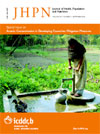
|
The Journal of Health, Population and Nutrition
icddr,b
ISSN: 1606-0997
EISSN: 1606-0997
Vol. 35, No. 1, 2016, pp. 1-6
|
 Bioline Code: hn16006
Bioline Code: hn16006
Full paper language: English
Document type: Research Article
Document available free of charge
|
|
|
The Journal of Health, Population and Nutrition, Vol. 35, No. 1, 2016, pp. 1-6
| en |
Bacteriological quality of bottled drinking water versus municipal tap water in Dharan municipality, Nepal
Pant, Narayan Dutt; Poudyal, Nimesh & Bhattacharya, Shyamal Kumar
Abstract
Background: Water-related diseases are of great concern in developing countries like Nepal. Every year, there are
countless morbidity and mortality due to the consumption of unsafe drinking water. Recently, there have been
increased uses of bottled drinking water in an assumption that the bottled water is safer than the tap water and its
use will help to protect from water-related diseases. So, the main objective of this study was to analyze the
bacteriological quality of bottled drinking water and that of municipal tap water.
Methods: A total of 100 samples (76 tap water and 24 bottled water) were analyzed for bacteriological quality and pH.
The methods used were spread plate method for total plate count (TPC) and membrane filter method for total coliform
count (TCC), fecal coliform count (FCC), and fecal streptococcal count (FSC). pH meter was used for measuring pH.
Results: One hundred percent of the tap water samples and 87.5 % of the bottled water samples were found to be
contaminated with heterotrophic bacteria. Of the tap water samples, 55.3 % were positive for total coliforms, compared
with 25 % of the bottled water. No bottled water samples were positive for fecal coliforms and fecal streptococci, in
contrast to 21.1 % and 14.5 % of the tap water samples being contaminated with fecal coliforms and fecal streptococci,
respectively. One hundred percent of the tap water samples and 54.2 % of the bottled water samples had pH in the
acceptable range.
Conclusions: All of the municipal tap water samples and most of the bottled drinking water samples distributed in
Dharan municipality were found to be contaminated with one or more than one type of indicator organisms. On the
basis of our findings, we may conclude that comparatively, the bottled drinking water may have been safer (than tap
water) to drink.
Keywords
Bacteriological quality; Fecal coliform count; Fecal streptococcal count; Total plate count; Total coliform count
|
| |
© Copyright 2016 - The Journal of Health, Population and Nutrition
Alternative site location: http://www.jhpn.net
|
|
